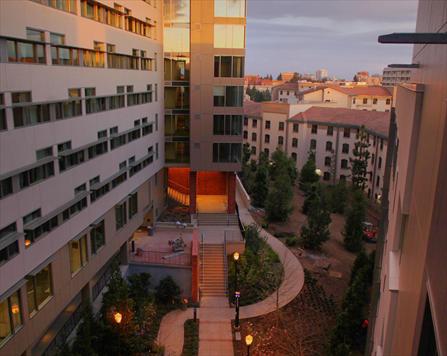The University of California, Los Angeles (UCLA) completed Holly Ridge and Gardenia Way, the newest buildings in the De Neve Plaza housing complex, capable of housing 800 students.
The construction of Holly Ridge and Gardenia Way finished several months ahead of schedule, allowing students to migrate to the new residence halls from the formally occupied Dykstra Hall in February.
Holly Ridge, also known as Upper De Neve, will house 496 students and Gardenia Way, also known as Lower De Neve, will house 307 students. Dykstra Hall will now undergo renovations to turn the 400-room building into a 10-story structure by 2013.
Holly Ridge and Gardenia Way are two of the four new resident hall additions to the UCLA campus as part of the Northwest Campus Student Housing In-Fill Project.
Upon completion, the Northwest Campus Student Housing In-Fill Project will add 500,000-sf of residential space including a 750-seat dining room, 1,525 bed spaces for single undergraduate students, student meeting rooms, and multi-purpose rooms that can accommodate up to 450 students. In total, the project will increase campus housing capacity from approximately 10,500 undergraduate students to approximately 12,000 in either new or renovated resident halls by fall 2013.
Gafcon Inc. and partner Benchmark Contractors are construction managers for the Northwest Infill project working alongside general contractor PCL Construction Services, Inc.
PCL Construction’s introduction of BIM for construction to the UCLA campus along with Gafcon’s SharePoint360 document storage services helped streamline project information for all partners and contributed to the early completion of the project. Architects for the project were Pfeiffer Partners Architects, Inc. and KieranTimberlake. BD+C
Related Stories
| Apr 12, 2011
American Institute of Architects announces Guide for Sustainable Projects
AIA Guide for Sustainable Projects to provide design and construction industries with roadmap for working on sustainable projects.
| Apr 11, 2011
Wind turbines to generate power for new UNT football stadium
The University of North Texas has received a $2 million grant from the State Energy Conservation Office to install three wind turbines that will feed the electrical grid and provide power to UNT’s new football stadium.
| Apr 8, 2011
SHW Group appoints Marjorie K. Simmons as CEO
Chairman of the Board Marjorie K. Simmons assumes CEO position, making SHW Group the only firm in the AIA Large Firm Roundtable to appoint a woman to this leadership position
| Apr 5, 2011
Zaha Hadid’s civic center design divides California city
Architect Zaha Hadid is in high demand these days, designing projects in Hong Kong, Milan, and Seoul, not to mention the London Aquatics Center, the swimming arena for the 2012 Olympics. But one of the firm’s smaller clients, the city of Elk Grove, Calif., recently conjured far different kinds of aquatic life when members of the City Council and the public chose words like “squid,” “octopus,” and “starfish” to describe the latest renderings for a proposed civic center.
| Apr 5, 2011
Are architects falling behind on BIM?
A study by the National Building Specification arm of RIBA Enterprises showed that 43% of architects and others in the industry had still not heard of BIM, let alone started using it. It also found that of the 13% of respondents who were using BIM only a third thought they would be using it for most of their projects in a year’s time.










